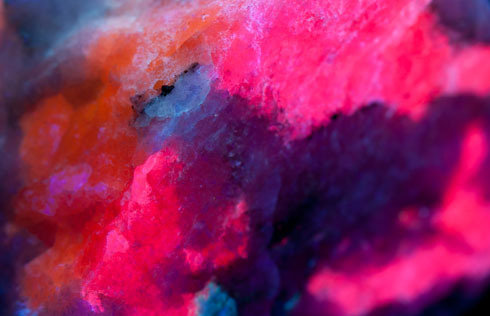Melvin Moti
dal 19/7/2012 al 20/10/2012
Segnalato da
19/7/2012
Melvin Moti
National Museum of Scotland, Edinburgh
One Thousand Points of Light. His new film and the objects shown in this exhibition make connections across traditional disciplines, combining the natural and the man-made, the ancient and the contemporary. Moti's film, Eigenlicht, was made in response to the collections at National Museums Scotland.

One Thousand Points of Light is an exhibition about light and
looking. Over the last year Dutch artist Melvin Moti has been
exploring the vast collections of National Museums Scotland.
His new film and the objects shown in this exhibition make
connections across traditional disciplines, combining the natural
and the man-made, the ancient and the contemporary.
Moti’s film, Eigenlicht, was made in response to the collections
at National Museums Scotland. Shot on 35mm film, Eigenlicht
flies silently around glowing, crazily-coloured rocks, or planets,
or particles. Slowly rotating against a black background the
film gives no indication of scale; we could be looking down a
microscope or out into space. Eigenlicht’s subjects are UV-
reactive minerals, minerals which absorb UV light, transforming
invisible light into visible, vibrant colours. Eigenlicht means
‘intrinsic light’ and Moti’s fascination with these rocks is their
apparent ability to produce their own light. Moti has said
‘however dead the material of the rocks might be, they still
seem to communicate to us.’
Alongside his film, Moti has selected objects for this exhibition
that exhibit a similar quality; a material ability to translate
invisible energy into something we can see. From scorpions
to scent bottles made with uranium glass, Moti suggests a
different grouping of objects than is usual in museums, bringing
a disparate group of objects together because of a shared
phenomenon. Within the exhibition these objects seem to be
the only sources of light in the darkness. Transformed under the
UV light, they are completely different to their normal daylight
appearance.
Moti chose to begin this exhibition with a small, and quite
strange, papier-mâché head. This head, while it looks like a
child’s toy, also visibly responds to an invisible force. Originally
owned by William Henry Fox Talbot, one of the inventors of
photography, the head formed part of Talbot’s collection of
optics and scientific apparatus. The head was used by Talbot
to demonstrate static electricity. When exposed to an electrical
charge, the human hair on the head would stand upright.
Photography too is an important consideration for Moti.
Eigenlicht, like all of his work, is made using analogue
processes. Moti chooses to use film, rather than a digital
media, because he is interested in slowing down and making
his work less readily consumed. Analogue processes, like that
invented by Talbot, are based upon chemical reactions to light.
The process ofphotography is simply the capture of light. The
word photography comes from photos meaning light, and
graphos meaning drawing or writing; literally writing with light.
Photographic plates mimic the process of looking, the light
hitting the photosensitive material, as the retina responds to the
light that enters our eyes.
The mechanics of vision have long been discussed and debated.
Ancient Greeks were divided between thinking of eyes as
receptors, or as much more active agents, considering looking as
emanating from the eyes, like a laser beam scanning the world.
Today science has revealed that our eyes are receptors, not
projectors, and yet the belief in the physical, active agency of
eyes is not entirely fanciful.
In the dark, or when we close our eyes, the world behind our
eyelids is never completely dark. Spots of colour and light swim
in front of our eyes. This phenomenon is, as Moti describes,
‘an entirely physical manifestation and no hallucination. The
light forms are created by our eyes themselves.’ Through this
creative potential, a seeming ability to create light, Moti draws
a parallel between our eyes and the the UV-reactive minerals;
both responding to external stimuli, but also transforming and creating new information themselves.
One Thousand Points of Light is a visual experience. Moti
asks us to look equally at ancient fossils and scent bottles, to
associate across milennia and from the natural to the man-made.
To reflect on looking and to consider the most basic processes
of how we come to know the world around us.
Bryony Bond
Showings of Eigenlicht take place in the exhibition gallery at 10:15, 11:00, 11:45, 12:30, 13:15, 14:00, 14:45, 15:30 and 16:15. The film runs for 18 minutes.
Image: Fluorescing mineral
Press contact:
Susan Gray Communications Manager Tel: 44 (0) 131 247 4088
Hannah Dolby Communications Officer Tel: 44 (0) 131 247 4288
Email: media@nms.ac.uk
National Museum of Scotland
Chambers Street Edinburgh EH1 1JF
Open daily from 10:00-17:00
Free admission



